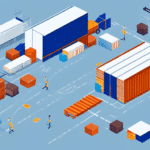The Critical Role of Last Mile Delivery in E-Commerce Success
With the exponential growth of e-commerce, the competition among online retailers has intensified significantly. To differentiate themselves and achieve success, retailers must ensure the efficient and timely delivery of products to customers. Last mile delivery — the final step in the supply chain where a package reaches the end customer — has become a pivotal factor in this endeavor.
Importance of Last Mile Delivery
Last mile delivery is the final touchpoint between the retailer and the customer, greatly influencing customer satisfaction and loyalty. According to a McKinsey report, last mile delivery can account for up to 53% of the total shipping cost. A positive delivery experience fosters customer loyalty and can lead to positive reviews, thereby enhancing a retailer's reputation and sales. Conversely, delays or inefficiencies can result in customer dissatisfaction and negative reviews.
Challenges in Last Mile Delivery
Despite its importance, last mile delivery poses several challenges for retailers:
- Timeliness: Customers expect rapid and reliable delivery, making timely arrival a critical factor.
- Cost Management: Last mile delivery often represents the most expensive part of the shipping process.
- Traffic and Weather: Unpredictable traffic and weather conditions can cause delays and increase costs.
- Package Security: Rising concerns over package theft, or "porch piracy," necessitate secure delivery solutions.
Overcoming Delivery Challenges
To address these challenges, retailers are adopting innovative solutions such as:
- Route Optimization: Utilizing software to plan the most efficient delivery routes.
- Real-Time Tracking: Offering customers the ability to track their packages in real-time.
- Flexible Delivery Options: Providing options like same-day, next-day, and weekend deliveries.
- Secure Delivery Solutions: Implementing lockers or requiring signature confirmations.
Technological Innovations Enhancing Last Mile Delivery
Technology plays a transformative role in optimizing last mile delivery:
Drones and Autonomous Vehicles
Emerging technologies such as drones and autonomous vehicles promise to revolutionize last mile delivery by reducing delivery times and costs. For instance, Amazon's Prime Air aims to deliver packages within 30 minutes using drones. Similarly, companies like Waymo are developing autonomous delivery vehicles to enhance efficiency.
Route Optimization Software
Advanced route optimization tools analyze traffic patterns, weather data, and delivery locations to determine the most efficient paths. This not only saves time but also reduces fuel consumption and operational costs. Software like Route4Me is widely used in the industry to streamline delivery operations.
Real-Time Tracking Systems
Providing customers with real-time tracking enhances transparency and trust. Systems like Tracktry allow customers to monitor their shipments, leading to increased satisfaction and reduced anxiety over delivery status.
Strategies for Optimizing Last Mile Delivery
Retailers can implement several strategies to enhance their last mile delivery operations:
Partnering with Third-Party Logistics Providers (3PLs)
Collaborating with specialized 3PLs enables retailers to leverage expert delivery networks without investing heavily in their own logistics infrastructure. Companies like ShipScience offer comprehensive last mile delivery solutions tailored to various business needs.
In-House Delivery Capabilities
Some retailers opt to build their own delivery fleets to maintain greater control over the delivery process. This approach can lead to enhanced customer service but requires significant investment and operational expertise.
Flexible Delivery Options
Offering multiple delivery options, such as scheduled deliveries or pickup points, caters to diverse customer preferences and reduces failed delivery attempts. Services like ShipScience Pickup Points provide convenient alternatives for customers to collect their packages.
Sustainability in Last Mile Delivery
Environmental considerations are increasingly influencing last mile delivery strategies:
Eco-Friendly Delivery Vehicles
Adopting electric or hybrid vehicles reduces carbon emissions and aligns with sustainable business practices. Companies like Tesla are at the forefront of providing eco-friendly delivery solutions.
Optimizing Delivery Routes
Efficient route planning not only saves time and costs but also minimizes the environmental impact by reducing fuel consumption. Integrating route optimization software is essential for achieving these goals.
Utilizing Bike Couriers
In urban areas, bike couriers offer a sustainable and efficient alternative to traditional delivery methods, especially for small packages and short distances.
The Future of Last Mile Delivery
The landscape of last mile delivery is evolving rapidly, driven by technological advancements and shifting consumer expectations:
Artificial Intelligence and Machine Learning
AI and ML can predict delivery patterns, optimize routes, and even foresee potential delivery issues, enabling proactive solutions. Tools like IBM Watson are being utilized to enhance delivery forecasting and performance.
Expansion of Drone and Autonomous Fleets
The integration of drones and autonomous vehicles is expected to grow, offering faster and more cost-effective delivery options. Regulatory advancements will play a crucial role in the widespread adoption of these technologies.
Alternative Delivery Methods
Innovative delivery methods, such as drone deliveries and smart lockers, are becoming more prevalent, providing customers with greater flexibility and convenience.
Impact of COVID-19 on Last Mile Delivery
The COVID-19 pandemic significantly accelerated the growth of e-commerce, placing unprecedented pressure on last mile delivery systems:
Increased Demand and Operational Strain
The surge in online shopping led to longer delivery times and heightened the risk of delays. Retailers had to scale their delivery operations rapidly to meet the increased demand.
Adoption of Safety Protocols
To protect delivery personnel and customers, retailers implemented new safety measures, including contactless deliveries and enhanced sanitization practices.
Shift Towards Essential Goods Delivery
The pandemic highlighted the importance of delivering essential goods, such as medical supplies and groceries, prompting a focus on prioritizing these deliveries within logistics operations.
Case Studies: Best Practices in Last Mile Delivery
Examining successful implementations of last mile delivery strategies provides valuable insights:
Amazon's Logistics Innovations
Amazon has invested heavily in its logistics network, including building its own delivery fleet, utilizing drones and robots, and offering accelerated delivery options like Amazon Prime Now. These initiatives have significantly enhanced delivery speed and reliability.
Zara's Click-and-Collect Service
Zara's click-and-collect model allows customers to order online and pick up their packages in-store. This strategy not only reduces delivery costs but also drives in-store traffic and enhances customer convenience.
ShipScience's Comprehensive Delivery Solutions
ShipScience has successfully partnered with various retailers to optimize their last mile delivery operations through advanced technology and tailored logistics solutions.
Choosing the Right Partner for Last Mile Deliveries
Selecting an appropriate last mile delivery partner is crucial for ensuring seamless operations:
Key Considerations
- Delivery Speed: The partner should meet your delivery timelines consistently.
- Cost Efficiency: Competitive pricing without compromising service quality.
- Reliability: Proven track record of successful deliveries.
- Flexibility: Ability to handle varying delivery volumes and adapt to changing needs.
- Communication: Transparent and effective communication channels.
Evaluating Potential Partners
Retailers should assess potential partners based on their capabilities, experience, and technological infrastructure. Engaging with partners like ShipScience can provide tailored solutions that align with specific business requirements.
Conclusion
Last mile delivery is a critical component of e-commerce success. Retailers must prioritize efficient, reliable, and timely delivery to remain competitive in the crowded online marketplace. By leveraging advanced technologies, implementing best practices, and fostering strong partnerships, e-commerce businesses can enhance their last mile delivery operations, ensuring customer satisfaction and driving sustained growth.




















